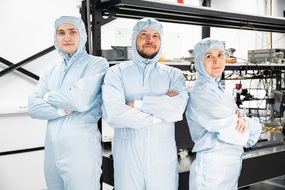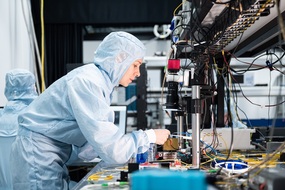Scientists from the MISIS University, in collaboration with colleagues from Skoltech and the National Medical Research Center for Obstetrics, Gynecology and Perinatology named after Academician V.I. Kulakov, have developed a platform for detecting clinical biomarkers of diseases in human biological fluids in real-time. It could serve as the first step towards creating a portable lab-on-a-chip for early detection of cancer, neurodegenerative, and cardiovascular diseases, as well as for monitoring treatment.
Scientists from the MISIS University, in collaboration with colleagues from Skoltech and the National Medical Research Center for Obstetrics, Gynecology and Perinatology named after Academician V.I. Kulakov, have developed a platform for detecting clinical biomarkers of diseases in human biological fluids in real-time. It could serve as the first step towards creating a portable lab-on-a-chip for early detection of cancer, neurodegenerative, and cardiovascular diseases, as well as for monitoring treatment.
The health status is reflected in biomarkers such as proteins, RNA, and DNA. These biomarkers are contained in extracellular vesicles, tiny bubbles that cells of tissues and organs release into their surrounding environment. Extracellular vesicles can be used for medical diagnostics at early stages of diseases. The markers they contain can be used in liquid biopsy, an innovative blood analysis method to determine the condition of biological systems.
“Owing to its high sensitivity, compact design, and safety, we see the future niche of our developed biosensor in working with low concentrations of extracellular vesicles when doctors do not have a clear understanding of the appropriateness of a particular treatment, and the final decision with all risks falls on the patient’s shoulders. Our sensor has the potential to become a new tool for such borderline cases, allowing not only to detect oncology at early stages but also to quickly adjust the chosen treatment path if it proves to be ineffective, for example, with incorrectly prescribed chemotherapy,” said Vadim Kovalyuk, head of the Laboratory of Photonic Gas Sensors at NUST MISIS.
Many common methods for searching for antibodies in blood require a large number of reagents and optical labels used to detect specific components. Therefore, there is a growing interest in highly sensitive and cost-effective methods for detecting cancer markers.
“The uniqueness of this development lies in the functionalization of the chip surface, which allows only the necessary substances to be captured from a complex solution, rather than the average refractive index of the substance above the chip’s optical waveguide. After measurement, layers can be washed off and new ones applied. Importantly, the developed platform is modular and can be easily adapted for the detection of protein compounds and viruses in the future through suitable surface modifications,” said Irina Florya, an engineer-researcher at the Laboratory of Photonic Gas Sensors at NUST MISIS.
The researchers designed a scalable platform based on a combination of photonic integrated circuits and microfluidic channels for measuring microliter volumes of liquids. Details were published in the scientific journal Applied Physics Letters (Q1).
“Experiments were conducted on extracellular vesicles isolated from the culture medium of ovarian cancer cells (SKOV3), which have high HER2 expression, and breast cancer cells (MDA-MB-231) with significantly lower HER2 expression. The research results showed that such a biosensor can be used for quantitative assessment of biological markers, such as extracellular vesicles containing the specific membrane protein HER2”, emphasized Aleksei Kuzin, a laboratory assistant-researcher at the Laboratory of Photonic Gas Sensors at NUST MISIS.
The technology could be the first step towards developing new diagnostic methods and creating a lab-on-a-chip that replaces a whole complex of expensive equipment for sample preparation, delivery, and analysis of analytes for biomedical applications.
The research was supported by the Ministry of Science and Higher Education of the Russian Federation (No. FSME-2022-0008) and grants from the Russian Science Foundation (No.
and No.






